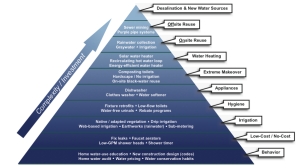The Virtual Water Project. is giving away their Virtual Water app for free all day on Thursday March 22, World Water Day. Sorry, Apple iOS only at this time. You can also order a poster showing the virtual water content of many food products.
If you’re not familiar with the concept of virtual water, read on or visit the Virtual Water Project website (link above).
[excerpt from waterfootprint.org]
Virtual water content: The virtual-water content of a product (a commodity, good or service) is the volume of freshwater used to produce the product, measured at the place where the product was actually produced (production-site definition). It refers to the sum of the water use in the various steps of the production chain. The virtual-water content of a product can also be defined as the volume of water that would have been required to produce the product at the place where the product is consumed (consumption-site definition). We recommend to use the production-site definition and to mention it explicitly when the consumption-site definition is used. The adjective ‘virtual’ refers to the fact that most of the water used to produce a product is not contained in the product. The real-water content of products is generally negligible if compared to the virtual-water content. [Read more at waterfootprint.org]



